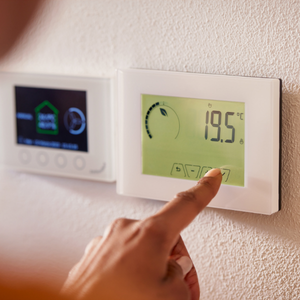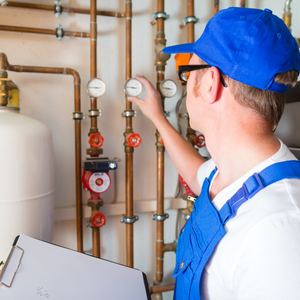
Winter can cause significant damage to empty mobile homes, including burst pipes and broken windows. While winterizing helps prevent costly repairs, it’s not always done. At Mobile Home Cash Offer, we buy mobile homes in any condition, making the process easy regardless of the home’s state.
What Is Mobile Home Winterization?
Mobile home winterization involves putting your home in protective mode for winter. You drain every drop of water so pipes can’t explode, set up security so troublemakers stay away, and make sure your place doesn’t freeze while you’re gone. In a nutshell, the whole process focuses on keeping water from freezing in your pipes.
You drain everything, add antifreeze to the drains, and set the heat high enough to keep things from turning into popsicles. Then you make the place look lived-in so nobody gets any bright ideas. Mobile homes are trickier than regular houses because all that plumbing runs underneath, where it’s cold and exposed. The walls are thinner, and everything sits higher off the ground, where wind can cause problems.
Why Winterizing Your Vacant Mobile Home Is Essential
Here are three significant reasons to winterize your mobile home if you’re still not convinced it’s beneficial.

- Water Damage from Frozen Pipes: Frozen pipes are disasters waiting to happen. When water freezes, it can split copper pipes and dump hundreds of gallons into your home before anyone notices. We’ve seen insurance claims that’ll blow your mind. Mobile home pipes freeze faster because they hang out in cold air under your home. Once it hits 20°F outside, maybe six hours before everything freezes. After that freeze-thaw cycle happens, your pipes are ruined. Insurance companies will deny your claim if they think you didn’t winterize properly. They want proof that you either kept the heat on or drained everything completely.
- Theft and Vandalism Risks: Empty mobile homes attract trouble. Criminals look for houses with stuffed mailboxes, piled-up newspapers, and that dead, empty look that reveals nobody’s home. Mobile home parks can be especially tricky because everyone knows everyone else’s business. Word travels fast when someone leaves for winter. Soon, you’ve got petty thieves and squatters making themselves comfortable in your mobile home. Most troublemakers just want easy targets. Make your place look occupied, and they’ll usually move on to bother someone else. Timer lights work wonders.
- Structural Damage Prevention: Winter weather beats up mobile homes pretty badly. All that temperature change can crack your walls, mess up your roof, and turn your investment into expensive problems. Moisture buildup is the real killer here. Temperature differences create condensation everywhere. Soon, you’re dealing with mold, rot, and structural damage that makes frozen pipes look cheap. We’ve watched decent mobile homes turn into expensive fixer-uppers because someone thought they could just lock the door and hope for the best. Don’t be that person.
Winterizing your mobile home protects your investment from damage, theft, and costly repairs. If you’re ready to move on, remember you can sell your mobile home for cash in Texas or nearby states fast and hassle-free.
How to Winterize Your Vacant Mobile Home
Shut Off and Drain All Water Lines
- Turn Off Main Water Supply: First, we need to find the main water shutoff valve. Most mobile homes have it underneath, usually near where the water line enters. Some parks have individual shutoffs at each lot. Once you find it, turn it off completely. Please give it a few extra turns to make sure it’s closed. If the valve is old and crusty, grab some WD-40 and add muscle.
- Drain All Fixtures and Appliances: Now turn on every single faucet and water outlet in your home—the kitchen sink, bathroom sinks, shower, bathtub, laundry connections, everything. Start upstairs if you have one, then work down. Let everything run until you get just sad little drips. This takes about 10 to 15 minutes. Don’t rush it; every drop you leave behind could freeze and crack your pipes.
- Empty Hot Water Tank: The challenging part is your hot water heater. First, turn off the power or gas. You don’t want it heating an empty tank. Then find the drain valve at the bottom. It looks like a garden hose connection. Hook up a hose and run it outside. Open the valve and let it empty. Fair warning: this takes forever, and the water will be nasty and rusty. Open the pressure relief valve at the top to help it drain faster.
Protect Your Plumbing System
- Add RV Antifreeze to Drains: Water hides in those sneaky P-traps under your sinks and in toilet bowls. RV antifreeze becomes your best friend here… the pink stuff made for plumbing, not the green automotive stuff. Pour about a cup down every single drain. The kitchen sink, bathroom sinks, shower drains, floor drains, and water go down a hole everywhere. The antifreeze settles in those P-traps and keeps any leftover water from freezing. Don’t forget weird drains like your washing machine drain or that floor drain in the utility room you never think about.
- Seal Toilets and Post Warning Signs: Flush toilets until the bowl is as empty as possible. You might need to hold the handle down or use a plunger. Then pour RV antifreeze into both the bowl and tank. Tape those toilet seats with duct tape and slap big signs on bathroom doors: “WINTERIZED! DO NOT USE.” We’ve seen well-meaning relatives mess up the whole process using winterized toilets. Make your signs big and obvious. Anyone entering your home should immediately know the plumbing is out of commission.
Insulate Pipes and Water Lines

- Wrap Exposed Pipes Under the Home: Next up, crawl under your mobile home with a flashlight and some pipe insulation. Look for any exposed water lines. They’re usually copper or plastic pipes running along the underside of your home. Foam pipe insulation is beneficial here. It’s cheap, easy to install, and works great. Just split it open and wrap it around every exposed pipe. Secure it with duct tape or zip ties. Pay special attention to pipes near the outer edges of your home where cold air hits hardest. These are the first to freeze and the most likely to cause problems.
- Install Heat Tape for Extra Protection: Heat tape is like an electric blanket for your pipes. It plugs into an outlet and keeps pipes warm enough to prevent freezing. Choose one with built-in thermostats. They turn on automatically when temperatures drop. Wrap heat tape around your most vulnerable pipes, especially those long runs under the home. Follow the manufacturer’s instructions exactly; this stuff can be a fire hazard if installed incorrectly. Make sure you have electrical outlets under your home, or you’ll need to run extension cords from inside. Keep everything dry and use outdoor-rated equipment.
Set Up Heating and Climate Control
- Set Thermostat to 50-55°F: Don’t turn your heat completely off. Set your thermostat to around 55°F. This will keep your home warm enough to prevent pipes from freezing without breaking the bank on heating bills. We know it feels weird heating an empty house, but trust us. The cost of keeping minimal heat running is nothing compared to fixing burst pipes and water damage. Plus, it keeps your home’s structure from getting too stressed by extreme cold. If you’ve got a programmable thermostat, set it and forget it. Some people try to get fancy with different temperatures for different times, but just pick 55°F and stick with it.
- Service Your Furnace Before Winter: Check your furnace before leaving town. Change the filter, ensure everything runs smoothly, and fix any weird noises or issues. The last thing you want is your furnace dying while sipping drinks on a beach somewhere. Clean or replace that furnace filter. A dirty filter makes your system work harder and can cause breakdowns. If you’ve got propane or oil heat, ensure your tanks are full and arrange for deliveries if needed. Have someone check on your home regularly while you’re gone. They should ensure the heat’s still running and the house feels warm when they walk in.
Secure the Mobile Home Exterior
- Repair Skirting and Seal Gaps: Your mobile home’s skirting is like armor against cold air getting underneath. Walk around your home and look for loose panels, holes, or gaps. Fix loose skirting panels with screws or replace damaged ones completely. You can use plywood, vinyl panels, or even cardboard as temporary fixes. The goal is to keep cold air out and warm air trapped under your home. Don’t forget about entry points where utilities come into your home. Seal around water lines, electrical connections, and gas lines with caulk or expanding foam. Every little gap lets cold air in.
- Clean Gutters and Secure Roof: Clean all the leaves and junk out of your gutters before winter hits. Clogged gutters cause ice dams, which cause water to back up and leak into your home. Spend an afternoon cleaning them now, or pay thousands later for water damage repairs. Check your roof for loose shingles, missing pieces, or obvious problems. You don’t need to become a roofing expert, but fix anything that looks sketchy. A small leak becomes a big problem when it freezes and thaws repeatedly.
Manage Utilities and Electronics
- Which Utilities to Keep On vs. Turn Off: Keep the electricity on. You need it for heat, security lights, and any monitoring systems. Keep gas on if you have a gas furnace, but turn off the supply to your water heater since you drained it. Water gets turned off completely at the main valve. We already covered this, but it’s worth repeating because it’s the most important step. Propane for heating stays on, but turn off propane to your water heater and other appliances you’re not using. Don’t try to save a few bucks on utilities. The money you save by turning things off won’t cover the damage if something goes wrong.
- Unplug Non-Essential Appliances: Unplug your microwave, coffee maker, TV, and other electronics you don’t need. This prevents damage from power surges and reduces fire risk. Plus, it saves a little money on your electric bill. You can leave your refrigerator plugged in, but clean it out first. You can turn the temperature up to save energy, but don’t turn it off unless you want to deal with mold and horrible smells when you return. Keep essential stuff in, including your furnace, security system, and lights on timers. Everything else can take a winter vacation along with you.
How Much Does It Cost to Winterize a Mobile Home?
Preparing your mobile home for winter is essential to prevent frozen pipes and costly damage. Whether you choose to do it yourself or hire a professional, understanding the costs can help you make the best decision.
- DIY Winterization Costs: Winterizing your mobile home typically costs between $100 and $200, including items like RV antifreeze, pipe insulation, and heat tape. You may also need basic tools such as a pipe wrench, duct tape, and zip ties if you don’t already have them. The most significant cost is often your time, as the process can take an entire weekend to complete properly.
- Professional Service Costs: Hiring a professional to winterize your mobile home typically costs $300 to $500 and may be cheaper if done through a mobile home park. Professionals offer thorough service, including blowing out water lines and checking hidden spots where water may linger. They’re insured and knowledgeable about local codes, providing peace of mind and added protection.
Choosing between DIY and professional winterization depends on your budget, time, and comfort level with home maintenance tasks. While doing it yourself can save money, hiring a pro ensures a thorough job and added security. Either way, winterizing is a smart investment in protecting your mobile home during cold weather, and if you’re ready to move on, you can sell your mobile home for cash in Ohio or nearby states quickly and easily.
Different Approaches for Different Vacancy Periods
Short-Term Vacant (1-3 Months)
If you’re only gone for a few months, you can take a lighter approach to winterization. Keep your heat set to 60°F instead of draining everything completely. This uses more energy but saves you the hassle of full winterization. You’ll still want to shut off the water to your washing machine and dishwasher to prevent hose failures. Also, ask someone to check on your home weekly and run water through the taps occasionally to keep things flowing.
You might want to install a smart thermostat to monitor and adjust your home’s temperature remotely. This way, you can ensure your heat stays on and catch any problems before they become disasters.
Long-Term Vacant (Entire Winter Season)
For extended absences, full winterization is your only safe bet. Follow all the steps we’ve covered: drain everything, add antifreeze, insulate pipes, and set minimal heat. Don’t try to skip anything since you will be gone for months. Arrange for someone to check your home at least once a week. They should ensure the heat’s running, there are no broken windows, and everything looks normal. Give them a key and your contact information in case of emergencies.
Pro Tip: Upgrade your security system before you leave. Motion sensors, cameras, and monitoring services become much more valuable when you’re not around to monitor things yourself.
De-Winterizing Your Mobile Home
When you return to your winterized mobile home, you need to do things in the correct order, or you might get an unpleasant surprise. Rushing through it can cause problems you want to avoid.
Before Going Inside:
- Walk around your home and check for obvious damage from winter storms.
- Look for broken windows, damaged skirting, or signs someone’s been around.
- Make sure utilities are still connected properly.
- Check that your heat is still running.

Inside Your Home:
- Don’t immediately turn on the water or flip every switch.
- Look for signs of water damage or frozen pipe problems.
- Turn the heat back up to normal temperature.
- Let your home warm up for a few hours before restoring water.
- Remove duct tape from toilets and take down warning signs.
- Check that RV antifreeze is still in your drains.
Restoring Water Service:
- Close all faucets you opened during winterization.
- Slowly turn on your main water valve. Don’t crank it open all the way.
- Listen for unusual sounds that might indicate problems.
- Turn on cold water faucets one at a time, starting closest to the water entry.
- Let each faucet run until water flows clear and steady.
- Expect some sputtering and weird-colored water at first.
Getting Hot Water Back:
- Close the water heater drain valve completely.
- Turn on the cold water supply to the tank.
- Wait for the tank to fill. You’ll know when hot water comes from faucets.
- Only then turn power or gas back on to your water heater.
- Wait 30-60 minutes for the water to heat up.
Final Testing:
- Flush all toilets and check for proper operation.
- Run the washing machine through a complete cycle.
- Test your dishwasher.
- Check under your mobile home for any signs of leaks.
- If you spot problems, turn off the water immediately and call a plumber.
- Reconnect any appliances you disconnected.
- Restore normal settings to the thermostat and other systems.
How Proper Winterization Attracts Cash Offers
Cash buyers look for mobile homes that won’t give them headaches. Proper winterization is like a neon sign that says you know what you’re doing. When buyers see well-insulated pipes, intact skirting, and zero evidence of freeze damage, they know they’re looking at a property that’s been cared for. These buyers have seen too many mobile homes with burst pipes and water damage, so finding one properly protected makes them pull out their checkbooks faster.
Cash buyers don’t mess around with financing delays or inspection drama. They’ve got money ready to spend and they’re looking for homes they can buy quickly without major repairs. A winterized mobile home checks all their boxes. It shows them that the property has been maintained, with less risk of hidden problems. They can close fast without worrying about lender requirements or costly surprises after purchase.
Key Takeaways: How to Winterize a Vacant Mobile Home (Prevent Costly Winter Disasters!)
This guide covers everything, including draining water lines, setting up security, and ensuring your property remains secure. The bottom line is simple: spend a weekend and a few hundred bucks now, or risk thousands in damage later.
The process isn’t complicated, but it requires attention to detail and following the steps correctly!
Ready to skip the winterization hassle and get a cash offer for your mobile home? At Mobile Home Cash Offer, we buy mobile homes in any condition, winterized or not. Contact us at 214-444-6375 for a no-obligation offer. Get started today!
| HOSE BIB | COMPRESSED AIR | HEATER | WATER HEATER | VALVE | VALVING |
| HOSE | PUMP | TANK | WATER PRESSURE | PRESSURE | DISHWASHER |
| WASHING MACHINE | SHOWERS | MACHINE | SHUT OFF THE WATER |
